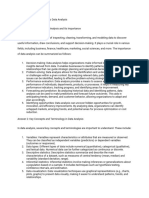0 ratings0% found this document useful (0 votes)
16 viewsUnit 1 Introduction To Data Analysis
………
Uploaded by
LIKITH KUMAR.SCopyright
© © All Rights Reserved
Available Formats
Download as PPTX, PDF, TXT or read online on Scribd
0 ratings0% found this document useful (0 votes)
16 viewsUnit 1 Introduction To Data Analysis
………
Uploaded by
LIKITH KUMAR.SCopyright
© © All Rights Reserved
Available Formats
Download as PPTX, PDF, TXT or read online on Scribd
You are on page 1/ 10
Unit 1
Introduction to Data Analysis
Meaning, Concepts
• Meaning of Data Analysis:
• Data analysis is the process of inspecting, cleaning, transforming, and
modeling data to discover useful information, support decision-making,
and identify patterns or trends. It involves interpreting raw data to derive
actionable insights for various purposes, such as business, research, or
policy-making.
• Key Concepts in Data Analysis:
• Data Collection: Gathering relevant data from various sources (surveys,
databases, sensors, etc.).
• Data Cleaning: Removing errors, inconsistencies, and outliers to ensure
data quality.
• Data Transformation: Converting data into a usable format (e.g.,
normalization, scaling, aggregation).
• Data Modeling: Applying statistical and machine learning models to
extract meaningful insights.
• Data Visualization: Presenting data in charts, graphs, and dashboards to
make the results understandable.
• Need for Data Analysis:
• Data analysis is essential in today's data-driven world for several reasons:
• Informed Decision Making: Helps businesses and organizations make
evidence-based decisions.
• Identifying Trends and Patterns: Reveals hidden insights from large datasets.
• Problem Solving: Facilitates the identification of problems and their solutions.
• Prediction: Supports forecasting future outcomes based on historical data.
• Optimization: Improves processes and resource allocation by analyzing
performance data.
• Advantages of Data Analysis:
• Better Decision-Making: Empowers organizations to make data-backed
decisions.
• Increased Efficiency: Identifies inefficiencies and optimizes operations.
• Competitive Advantage: Helps businesses gain insights into customer
preferences and market trends.
• Risk Management: Identifies potential risks and helps in mitigating
them.
• Cost Reduction: Provides opportunities for cost-saving through data-
driven improvements.
• Disadvantages of Data Analysis:
• Data Privacy Concerns: Handling personal and sensitive information
poses ethical and legal risks.
• Data Overload: Excessive data can be overwhelming, making it difficult to
extract meaningful insights.
• Cost and Resources: Requires significant investment in tools,
infrastructure, and skilled personnel.
• Bias and Misinterpretation: Poorly designed analyses or incorrect
interpretations can lead to flawed conclusions.
• Complexity: Data analysis, especially involving big data, can be
technically complex and time-consuming.
• Common Data Analysis Problems:
• Inconsistent Data: Data from multiple sources may have varying formats,
causing difficulties in integration.
• Missing or Incomplete Data: Key data points might be missing, leading to
biased results.
• Outliers and Anomalies: Unusual data points can distort analysis results.
• Data Bias: Biased data can lead to incorrect conclusions.
• Scalability Issues: Handling and analyzing large datasets require advanced
tools and techniques.
• Data Interpretation: Misinterpretation of analysis results can lead to
incorrect decisions.
• Understanding and Solving Data Analysis Problems:
• Define the Problem:
• Clearly identify the business or research problem you aim to solve with data.
• Understand the scope and objectives.
• Data Collection:
• Gather the necessary data from relevant sources.
• Ensure data relevance and quality during collection.
• Data Cleaning:
• Handle missing values, remove duplicates, and manage inconsistencies.
• Use techniques like imputation or removal to address missing data.
• Data Analysis Techniques:
• Apply suitable methods such as statistical analysis, machine learning, regression models, etc.,
based on the problem type.
• Use exploratory data analysis (EDA) to understand the basic structure of the data.
• Data Visualization:
• Use graphs, charts, and dashboards to visualize patterns, trends, and key insights.
• Ensure clarity and simplicity in presentation for non-technical stakeholders.
• Interpretation and Decision-Making:
• Draw conclusions from the analyzed data and relate it to the original problem.
• Use insights for decision-making and recommend actions based on the analysis results.
You might also like
- Chapter 1 Introduction To Data AnalyticsNo ratings yetChapter 1 Introduction To Data Analytics4 pages
- Data Analysis Is The Process of GatheringNo ratings yetData Analysis Is The Process of Gathering5 pages
- Instant Access to Data Analysis for Beginners: 2 in 1 Guide: A Beginner's Adventure in Analysis and Visualization Daniel Garfield ebook Full Chapters100% (3)Instant Access to Data Analysis for Beginners: 2 in 1 Guide: A Beginner's Adventure in Analysis and Visualization Daniel Garfield ebook Full Chapters37 pages
- Download full Data Analysis for Beginners: 2 in 1 Guide: A Beginner's Adventure in Analysis and Visualization Daniel Garfield ebook all chapters100% (1)Download full Data Analysis for Beginners: 2 in 1 Guide: A Beginner's Adventure in Analysis and Visualization Daniel Garfield ebook all chapters37 pages
- Data Analysis Is The Process of Gatherin1No ratings yetData Analysis Is The Process of Gatherin15 pages
- Assignment 1 - Introduction To Data AnalysisNo ratings yetAssignment 1 - Introduction To Data Analysis3 pages
- DecodingDataYourJourneytoInsights_sK0tHmRRNo ratings yetDecodingDataYourJourneytoInsights_sK0tHmRR12 pages
- As You Delve Into The World of Data AnalyticsNo ratings yetAs You Delve Into The World of Data Analytics10 pages
- Programming in C: Constants, Variables, and Data TypesNo ratings yetProgramming in C: Constants, Variables, and Data Types11 pages
- ISC Computer Project/Computer File JAVANo ratings yetISC Computer Project/Computer File JAVA30 pages
- How To - HP-UX UNIX Backup and Recover Data To Tape DeviceNo ratings yetHow To - HP-UX UNIX Backup and Recover Data To Tape Device10 pages
- Project Report On Computer Application in BusinessNo ratings yetProject Report On Computer Application in Business8 pages
- SAP Geographical Enablement Framework (SAP GEF)No ratings yetSAP Geographical Enablement Framework (SAP GEF)19 pages
- Business Analytics Level 1 Quiz - Attempt ReviewNo ratings yetBusiness Analytics Level 1 Quiz - Attempt Review14 pages
- Data Analysis and Data Wrangling With Python - Advanced Python CourseNo ratings yetData Analysis and Data Wrangling With Python - Advanced Python Course19 pages
- Practical Research 2: Quarter 1 - Module 2100% (3)Practical Research 2: Quarter 1 - Module 237 pages
- Lecture-1to8-HCL-DSE - Sumita Narang - IDS PDFNo ratings yetLecture-1to8-HCL-DSE - Sumita Narang - IDS PDF304 pages
- Numpy NP Pandas PD Matplotlib - Pyplot PLT Seaborn SNS: "Merged - Uscol - TXT" ","No ratings yetNumpy NP Pandas PD Matplotlib - Pyplot PLT Seaborn SNS: "Merged - Uscol - TXT" ","18 pages
- EDUC-119 Week2 QualitativevsQuantitativeNo ratings yetEDUC-119 Week2 QualitativevsQuantitative19 pages
- Data Structures For Statistical Computing in PythoNo ratings yetData Structures For Statistical Computing in Pytho7 pages
- AKINOLA OMOLOLA HRM 703 Tutorial AssignmentNo ratings yetAKINOLA OMOLOLA HRM 703 Tutorial Assignment36 pages
- Instant Access to Data Analysis for Beginners: 2 in 1 Guide: A Beginner's Adventure in Analysis and Visualization Daniel Garfield ebook Full ChaptersInstant Access to Data Analysis for Beginners: 2 in 1 Guide: A Beginner's Adventure in Analysis and Visualization Daniel Garfield ebook Full Chapters
- Download full Data Analysis for Beginners: 2 in 1 Guide: A Beginner's Adventure in Analysis and Visualization Daniel Garfield ebook all chaptersDownload full Data Analysis for Beginners: 2 in 1 Guide: A Beginner's Adventure in Analysis and Visualization Daniel Garfield ebook all chapters
- Data Analytics and Data Processing EssentialsFrom EverandData Analytics and Data Processing Essentials
- Programming in C: Constants, Variables, and Data TypesProgramming in C: Constants, Variables, and Data Types
- How To - HP-UX UNIX Backup and Recover Data To Tape DeviceHow To - HP-UX UNIX Backup and Recover Data To Tape Device
- Project Report On Computer Application in BusinessProject Report On Computer Application in Business
- Data Analysis and Data Wrangling With Python - Advanced Python CourseData Analysis and Data Wrangling With Python - Advanced Python Course
- Numpy NP Pandas PD Matplotlib - Pyplot PLT Seaborn SNS: "Merged - Uscol - TXT" ","Numpy NP Pandas PD Matplotlib - Pyplot PLT Seaborn SNS: "Merged - Uscol - TXT" ","
- Data Structures For Statistical Computing in PythoData Structures For Statistical Computing in Pytho

























































































